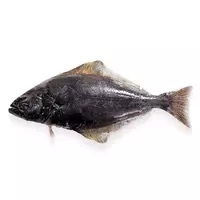Halibut fish

Halibut fish unites under one common name 4 varieties of fish, which are referred by scientific classification to the Kambalov family and the order Kambalatysky. Flounder fish live mainly in the salty waters of the northern seas and oceans. The largest population of halibut fish is found in the North Pacific and Atlantic Ocean. Halibut is also found in the waters of the Bering, Barents, Japan and Okhotsk Seas. All four varieties of halibut live off the coast of the Russian Federation, which allows commercial extraction and harvesting of fish.
The following types of halibut fish are distinguished:
White-haired halibuts live in the waters of the Atlantic Ocean, so the species is often called the Atlantic halibut. Such a fish reaches record levels in size. The largest Atlantic halibut weighed 337 kg, and reached a length of just under 5 meters.
Arrow-toothed halibut is divided into two subspecies - Asian and American arrow-toothed halibut. Both the first and second species do not exceed 80 cm in length, and the weight of the fish is within 3 kg.
Black or blue-breasted halibut.
Halibut fish are predatory species of fish that live at a relatively shallow depth and reach an age of 30 years. Halibut is listed in the International Red Book as a species on the verge of extinction. The main reason for this situation is the extraction of fish on an industrial scale. Halibut meat and fish caviar are used in cooking. Usually frozen or smoked halibut fish can be found on sale. Often there are canned fish with halibut, which are made with the addition of vegetable oils or in their own juice.
The calorie content of halibut is at a fairly low level and is only 142 Kcal per 100 grams of product. Such a low calorie level of halibut and vitamin-mineral composition allows you to classify fish as healthy and dietary products. However, it is worth remembering that halibut belongs to those types of fish that perfectly absorb oil during preparation, so the calorie content of the final fish dish may differ by 4 times from the initial indicators. Halibut fish are baked and deep-fried or breaded. Halibut meat is a great match with vegetable ingredients. Fish is added to soups, as well as smoked and salted.
Benefits of halibut
The useful properties of halibut are in the chemical composition of the product. Rich in the content of vitamins of group A, V1, V2, V5, V6, V12, E, as well as D, the chemical composition of fish is considered the main benefit of halibut for the human body. The exceptional benefits of halibut are also in minerals such as magnesium, iron, selenium, calcium and potassium. It is worth paying attention to a large number of natural Omega-3 polyunsaturated acids, which are considered indispensable for the human body.
In addition to all of the above, the useful properties of halibut are the content of seven amino acids that the human body needs. Aspartic and glutamic acid, as well as valine, lysine, alanine, leucine and arginine participate in most vital processes of the human body, as well as prevent the occurrence of cancer and are contained in halibut.
fish halibut 142 kCal
Energy value of fish halibut (Ratio of proteins, fats, carbohydrates - ju):
Proteins: 18.56 g (~ 74 kCal)
Fats: 1.33 g (~ 12 kCal)
Carbohydrates: 0 g (~ 0 kCal)
Energy ratio (b | y): 52% | 8% | 0%
 Español
Español Français
Français Português
Português Русский
Русский 简体中文
简体中文 繁體中文
繁體中文 日本語
日本語 한국어
한국어 العربية
العربية Türkçe
Türkçe Қазақ
Қазақ Deutsch
Deutsch Italiano
Italiano Українська
Українська
